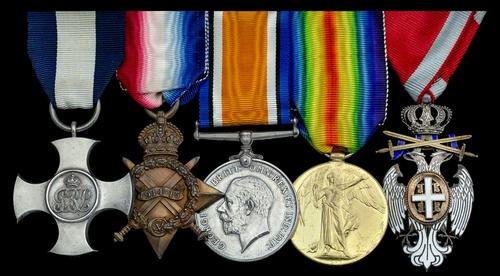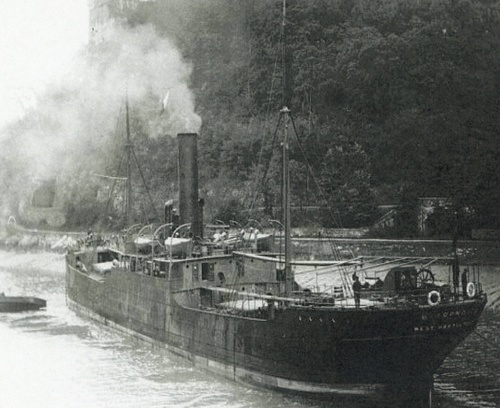Auction: 18003 - Orders, Decorations and Medals
Lot: 565
A fine Great War 'Serbian Evacuation' D.S.C. group of five awarded to Lieutenant A. Adams, Royal Naval Reserve, who helped to rescue troops from the Principe Umberto which struck a mine and broke in two off Linguetta in December 1915
Having then survived the wreck of the Manzanita in the Adriatic, he went on to lend valuable service in Q-Ships, gaining a 'mention' for his part in the gallant last stand made by the Chagford in a protracted action in the North Atlantic in August 1917
Distinguished Service Cross, G.V.R., hallmarks for London 1916, in its Garrard, London case of issue; 1914-15 Star (Lieut. A. Adams, R.N.R.), in its card box of issue; British War and Victory Medals (Lieut. A. Adams. R.N.R.), the last also in its card box of issue; Serbia, Kingdom, Order of the White Eagle, Military Division, Fifth Class breast Badge, silver-gilt and enamel, in its case of issue, minor enamel loss to reverse of last, otherwise nearly extremely fine (5)
D.S.C. London Gazette 14 July 1916:
'For services in connection with the evacuation of the Serbian Army and Italian troops from Darazzo, Dec. 1915 - Feb. 1916.'
His service record notes:
'Went to assistance of transport Re: Umberto, when mined on 4/12/15 and by his prompt and courageous action was instrumental in saving many lives.'
Serbian Order of the White Eagle, Fifth Class with Swords London Gazette 1 March 1917.
Arnaud Adams was born at Stockton-on-Tees, County Durham, on 27 November 1891. A merchant seaman by profession, he served aboard the cargo ship Merchant Prince which specialised in trade between the United Kingdom and the Eastern Mediterranean.
Commissioned in the Royal Naval Reserve in December 1914, he served briefly aboard the Admirable in the Adriatic, before returning to England to an appointment in the Dreel Castle in February 1915. The Dreel Castle was a drifter which later became tender for the Auxiliary Patrol Base at Falmouth, Cornwall.
Re-joining Admirable in the Mediterranean later in the same year, Adams was involved in the rescue of Italian and Serbian troops from the stricken Principe Umberto on 4 December 1915, when she struck a mine laid by the German submarine UC-14; according to contemporary accounts the Principe Umberto broke into two sections within 15 minutes and 94 people drowned. Remaining likewise employed in the evacuation of Serbian and Italian troops from Durazzo until the new year, Adams was awarded the D.S.C.
Discharged to Fort St. Angelo at Birgu, Malta, Adams next joined the former Lowestoft drifter Manzanita; she had earlier been employed as a tender in the Adriatic and had been the base ship for the Otranto Barrage at Brindisi. In September 1916, the British drifters transferred their base to Taranto, and whilst on passage the Manzanita ran aground on the Ugenti Rocks outside Bari. Badly damaged, she was written off as a wreck. Adams consequently joined the Queen at Taranto, which ship was in the process of refitting as a depot ship for the personnel of the Adriatic anti-submarine net barrage.
Q-Ships
On 18 June 1917, Adams returned to active duty with a posting to the 2,905-ton steamship Bracondale which had been in the employment of the Admiralty until spring 1917 as a collier. Converted into a 'useful Q-ship', she was re-commissioned in April and renamed the Chagford; she was fitted out at Devonport with a 4-inch gun, two 12-pounders and a pair of torpedo tubes.
Commanded by Lieutenant D. G. Jeffrey, R.N.R., she proceeded to Falmouth and thence to the naval base at Buncrana, on Lough Swilly, County Donegal, where she is described as quickly 'looking for business' (Bayly's War: The Battle for the Western Approaches in the First World War, refers). At 4.10 a.m. on 5 August 1917, roughly 120 miles equidistant from Northern Ireland and the west coast of Scotland, Chagford did indeed find 'business'. E. Keble Chatterton's Q-ships and Their Story takes up the story:
'At the time mentioned she (Chagford) was herself torpedoed just below the bridge, and in this one explosion was caused very great injury: for it disabled both her torpedo tubes and her 4-inch gun; it shattered the boats on the starboard side as well as the Captain's cabin and chart room. In addition, it also wrecked all the voice-pipe connections to the torpedo tubes and guns, and it flooded the engine-room and put the engines out of commission, killing one of the crew.'
Jeffery sent away the 'abandon Chagford' party, consisting of a 'lifeboat, dinghy and a barrel raft', but just as the boats were getting away, a submarine surfaced on the starboard side 800 yards away. Jeffery immediately ordered 'open fire' at the top of his voice and both 12-pounders and the Lewis guns opened-up, several direct hits being observed. The submarine then dived and at 4.40 am she fired a second torpedo at Chagford which hit the ship abaft the bridge on the starboard side.
From the time the first torpedo had hit, the enemy realised that Chagford was a warship, for the 4-inch gun and torpedo tubes had been made visible, and now that the ship had been torpedoed for a second time, Lieutenant Jeffrey decided to recall his decoy boats so that the ship might genuinely be abandoned. Leaving a skeleton crew of six, the boats were accordingly filled, just before the enemy fired a third torpedo which struck again the starboard side. According to Keble Chatterton:
'Here was another doomed ship rolling about in the Atlantic without her crew, and only a gallant handful of British seamanhood still standing by with but a shred of hope. To accentuate their suspense, periscopes were several times seen and from 9 a.m. until 9 p.m. a submarine frequently appeared on the surface at long range.'
That evening, Lieutenant Jeffrey, fearing boarding, placed the Lewis guns in position and 'served out rifles and bayonets to all'; by midnight the prospect of defending her lay in tatters, much like her hull, for the Chagford had been split from side to side and was sinking fast. Taking to a small launch, they left her to the deep and were picked up the next morning by H.M. Trawler Saxon. Difficult as the encounter had been, Chagford had done real service; the U-44 could not submerge for a sustained period of time or to any great depth. On 12 August she was shelled and then rammed by the Oracle off the coast of Norway. The loss of Chagford had been avenged.
For his gallant role in leading the decoy party, Adams was mentioned in despatches (London Gazette 17 November 1917), his service record noting: 'Showed exceptionally good judgement in setting sail and getting away from ship after she was torpedoed on the 8 (sic) August 1917'.
In September 1917, Adams was given command of the former British freighter Arvonian, then converting for use as a Q-Ship. Having assisted in her fitting out and trials, he handed her over to the United States Navy.
In February 1918, Adams was posted to the Q-Ship Pargust. One of the most famous decoy ships of the war; she had undergone extensive repairs following her last memorable action with the UC-29 in the summer of 1917. In May 1918, the Pargust transferred to Gibraltar where she joined a special service force for patrol work in the Mid-Atlantic and western Mediterranean.
Adams was demobilised in August 1919 and likely returned home to 22 Baker Street, Middlesbrough, with his new wife Lilian Moore; they had been married at the Parish Church, Falmouth, on 6 September 1917 - less than a month after his Chagford adventure.
Sold with the recipient's original M.I.D. certificate, in the name of 'Lieutenant Arnaud Adams, D.S.C., R.N.R.', dated 17 November 1917; together with a letter from the Serbian Legation, informing Adams at Devonport that they are now in receipt of his Order, dated 30 August 1917; large Diploma Certificate of the 5th Class of the Serbian Order of the White Eagle, and related forwarding letter from the Admiralty, dated 17 December 1921.
Subject to 20% VAT on Buyer’s Premium. For more information please view Terms and Conditions for Buyers.
Sold for
£2,100







